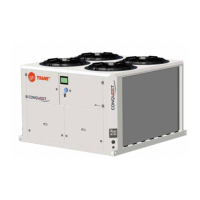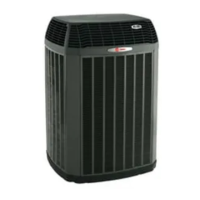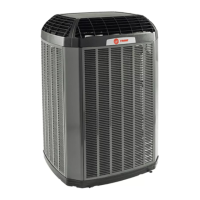CG-SVX027E-GB
48
4 UNT-PRC002-GB
Technical Data
FWD 08 12 20 30 45
Power supply (V/Ph/Hz) 230/1/50
Capacities
Cooling capacity on water (1) (kW) 5,2 8,3 15 18,8 30,1
Heating capacity on water (2) (kW) 6,3 11,9 18,9 20,9 38,2
Fan motor (type) 2 x direct drive centrifugal
Fan power input (3) (kW) 0,23 0,46 0,65 1,04 1,51
Current amps (3) (A) 1,1 2,2 3,1 4,7 5,5
Start-up amps (A) 3,2 5,5 9,3 14,1 16,5
Air flow
minimum (m
3
/h) 490 980 1400 1800 2700
nominal (m
3
/h) 820 1650 2300 3000 4500
maximum (m
3
/h) 980 1970 2600 3600 5400
Main coil
Water entering/leaving connections (type) ISO R7 rotating female
(Dia) 3/4" 3/4" 1 1/2" 1 1/2" 1 1/2"
Electric heater (accessory for blower only)
Electric power supply (V/Ph/Hz) 230/1/50 230/1/50 or 400/3/50 400/3/50 400/3/50 400/3/50
Heating capacity (kW) 2/4 8 10 12 12
Hot water coil (accessory for blower only)
Heating capacity (4) (kW) 6,3 12 17,4 22,4 34,5
G2 filter (filter box accessory)
Quantity 2 2 2 2 2
Dimensions ( LxWxth) (mm) 386x221x8 486x271x8 586x321x8 586*421*8 586*621*8
G4 filter (filter box accessory)
Quantity - 2 2 2 2
Dimensions ( LxWxth) (mm) - 486x264x48 586x314x48 586*414*48 586*614*48
Condensate pump (accessory) (type) Centrifugal
Water flow - lift height (l/h - mm) 24 - 500
Not available for FWD30 and FWD45
Sound level (L/M/H speed)
Sound pressure level (5) (dB(A)) 36/40/43 38/41/44 46/50/53 47/52/57 47/52/58
Sound power level (5) (dB(A)) 46/50/53 48/51/54 56/60/63 57/62/67 57/62/68
Unit dimensions
Width x Depth (mm) 890 x 600 1090 x 710 1290 x 820 1290 x 970 1290 x 1090
Height (mm) 250 300 350 450 650
Shipped unit dimensions
Width x Depth (mm) 933 x 644 1133 x 754 1333 x 864 1333 x 1008 1333*1133
Height (mm) 260 310 360 460 660
Weight (kg) 32 46 61 76 118
Colour galvanised steel
Recommended fuse size
Unit alone (aM/gI) (A) 8/16 8/16 8/16 8/25 8/25
Unit with electric heater (gI) (A) 16 (2kW),25 (4kW) 40 (230V),3*16 (400V) 3*20 3*25 3*25
(1) Conditions: Water entering/leaving temperature: 7/12 °C, Air inlet temperature 27/19°C DB/WB - Nominal air flow
(2) Conditions: Water entering/leaving temperature: 50/45 °C, Air inlet temperature 20°C DB - Nominal air flow
(3) At high speed with nominal air flow.
(4) Water entering/leaving temperature 90/70 °C, air inlet temperature 20 °C DB, Nominal air flow.
(5) A rectangular glass wool duct 1m50 long is placed on the blower.The measurement is taken in the room containing the blower unit.
Heat exchanger operating limits:
FWD:
*water temperature: max 100° C
*absolute service pressure: min 1 bar/max 11 bars
Accessories - Hot water coil:
*water temperature: min. +2° C/max. 100° C
*absolute service pressure: min 1 bar/max 11 bars
Maintenance
Pump maintenance
Pumps motor bearings and mechanical seals have
a designed life expectancy of 20000-25000 hours of
operation. For critical applications it might be necessary
to change the components as a preventive measure.
Compressors Service Information
Oil Equalizer line
CSHD Compressors
The oil equalizer line is equipped with a Rotolock tting
for easy removal. Torque value for tightening these
tting is 90 N.m. Before removing the oil equalizer line,
the system refrigerant charge must be recovered before
draining the oil. Use a catch pan to catch the oil when
the compressor oil equalizer line is loosened to ensure
that oil does not spill out of the compressor when the
equalizer line is removed.
Tandem and Trio Compressor Suction Restrictors
Since most uneven tandem and trio compressor sets
require the use of a restrictor in the suction line of one
or more compressors in order to provide correct oil level
balance between compressors when they are operating.
Compressor Replacement
If the CGAX/CXAX chiller suffers a failed compressor,
use these steps for replacement:
Each compressor has lifting eyes. Both lifting eyes must
be used to lift the failed compressor. DO NOT LIFT A
COMPRESSOR USING A SINGLE LIFTING EYE. Use
proper lifting techniques, a spreader bar and rigging as
for lifting both compressors simultaneously.
Compressor weights by compressor model are:
DSH 092 – 58 kg.
DSH 125 – 64 kg.
DSH 142 – 67 kg.
DSH 161 – 69 kg.
DSH 183 – 76 kg.
After a mechanical failure of a compressor, it
is necessary to change the oil in the remaining
compressor and also replace the liquid line lter
drier. After an electrical failure of a compressor, it will
also be necessary to change the oil in the remaining
compressor, replace the liquid line lter drier and add a
suction lter drier with cleanup cores.
Note: Do not alter the refrigerant piping in any way as
this can affect compressor lubrication.
Note: Do not add a suction lter drier within 250mm of
the elbow for CSHD compressors.
Refrigerant System Open Time
Model CGAX/CXAX chillers use POE oil (Trane
recommended oil OIL 048E or OIL 023E) and therefore
refrigerant system open time must be kept to a
minimum. The following procedure is recommended:
• Leave a new compressor sealed until it is ready to
be installed in the unit. Maximum system open time
is dependent upon ambient conditions, but do not
exceed one hour open time.
• Plug the open refrigerant line to minimize moisture
absorption. Always change the liquid line lter drier.
• Evacuate the system to 500 microns or below.
• Do not leave POE oil containers open to the
atmosphere. Always keep them sealed.
Mechanical Compressor Failure
Replace the failed compressor(s) and change the oil in
the remaining compressor(s) along with the refrigerant
system liquid line lter drier.
Electrical Compressor Failure
Replace the failed compressor and change the oil in
the other compressor(s). Also add a suction lter with
cleanup cores and change the liquid line lter drier.
Change lters and oil until the oil no longer test acidic.
See “Oil Testing.”
Compressor Motor Megging
Motor megging determines the electrical integrity of the
compressor motor winding insulation. Use a 500 volt
megger. A less than 1 meg-ohm reading is acceptable
and 1000 ohms per nameplate volts is required to safely
start the compressor.
Compressor Current Imbalance
Normal current imbalance could be 4 to 15 percent
with balanced voltage due to motor design. Each phase
should register .3 to 1.0 ohms and each phase should
be within 7 percent of the other two phases. Phase to
ground resistance must be innity.
Note: Maximum allowable voltage imbalance is
2percent.

